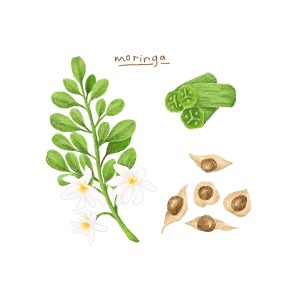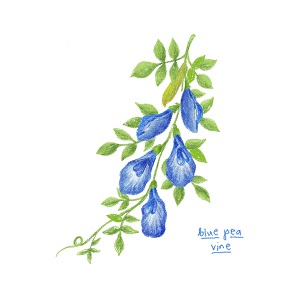Urban farming and home gardening are terms we have begun to hear on an increasing frequency, especially in light of the nation’s continued move towards sustainability. Join our three authors as they share their thoughts and journeys on tending to their gardens of fruit trees, herbs and vegetables. Alongside these writings are illustrations by Dr Thio Simin, each inspired by what our three authors have shared.
Chin Wah Seng
Since the formation of “The Doctors Garden” chat group in 2017, I have been promoting the growing of two plants – the Moringa oleifera and the Blue Pea Vine – for their aesthetics and nutritional values. They can both be easily grown in Singapore.
The Moringa, also known as Kelo or Drumstick locally, is famous for its pods which look like drumsticks. The leafy plant is particularly dear to Indians and Peranakans who often use the pods in curries. However, it is the leaves that take the prize, as they contain an unusually high intensity of nutrients. The scientific evidence even prompted the World Health Organization to promote mass cultivation of Moringa in the poor parts of Africa, like Senegal. The leaves are harvested to supplement the nutrition of the local folks, especially children, due to its high content of plant protein, vitamins and minerals. Google Moringa to view the many impressive educational videos.
The leaves can be eaten raw, blanched or cooked as vegetables. When dried (or dehydrated), they make a pleasant and nutritious tea. Other than the leaves, the bark can also be used for tea. The Moringa seeds are full of oil, antioxidants and nutrients. The old seeds are natural sweeteners.
It is little wonder that the plant has been proclaimed the “Miracle Tree”. The Indians even consider it a divine tree that wards off evil.
The Blue Pea Vine is famous for its blue flower, which has been honoured in one of our local stamps. Traditionally, the blue pigment in the flower has been used to colour Nonya kueh (cakes), but scarcity of the plant has forced the use of synthetic dyes in modern days. The nutritional value lies in the blue pigment. It contains high concentrations of anthocyanin, one of the most powerful antioxidants found in all blue, purple, red and dark red fruits and vegetables (eg, the blueberry which is acknowledged as a super food). The Singapore Biopolis even conducts ongoing medical research looking into it. The Blue Pea Vine’s flowers decorate salads beautifully and can be eaten raw. However, the best use for it is to make an attractive blue-coloured herbal tea. I have been drinking this blue tea daily in place of plain water for years; no ill-effects!
The Blue Pea plant is a climbing vine. Thus, it is best to plant it along your fence in full sun and you will soon get a wall of blue flowers. It can also be easily grown from seeds. The colour of its flowers varies from a dainty light blue to a heavy dark blue-purple. The petals can be single or multiple, which can make it look similar to a blue rose!
I love gardening. It functions as my outdoor exercise; using the changkol, spade, saw, metal wedge, chopper, etc, in the garden, all limb/trunk muscles and joints are vigorously moved. Then comes the crowning joy of seeing plants and trees with new life emerging and old ones invigorated after trimming to flourish healthily.
Marcus Teo Kai Jie
Gardening adds years to your life and life to your years.
Gardening has always been a hobby of mine. As a child, I loved to go to the Singapore Botanic Gardens and look at the myriad of plants being nurtured. As I grew older, the annual pruning of the household garden and the planting of new shrubs and flowers for Lunar New Year became the norm.
With every storm cloud, there is always a silver lining. For me, the occurrence of COVID-19 gave me more time to spend at home and rediscover my passion for gardening. The journey has made me realise how gardening and medicine do indeed share many parallels.
The garden to me, is a great teacher. It has educated me on patience, watchfulness and the importance of tender, loving care. There are also many factors at play in the garden: the amount of water, type of soil, balance of macro and micronutrients – the list could be endless. And of course, the biggest nemesis of all gardeners are the pests. You may have to watch the fruits of your labour rot and wilt as you try every household remedy to organically save them.
One such experience was when my plants got infected by white mealy bugs, a common occurrence during the monsoon season. The overwatered soil led to the demise of the plant’s immunity, increasing its susceptibility to attacks from pests. The first thing one will notice is that the leaves of your plants start wilting and growth stalls tremendously. Only on closer examination will one see the minute bugs, feeding on the stems and underside of the leaves, sucking the life essence away from the plant. The key is to strike early by applying a homemade organic pesticide mix made with neem oil, and killing them before they multiply. If not, drastic measures such as a total pruning of the plant may be called for. The best treatment though, is prevention. Sounds familiar? Well, that’s because diseases work the same way, be it on humans or plants!
Green initiatives are also one of the aspects of gardening that I love. Using my own kitchen waste, fallen leaves and even grass clippings from my neighbours, I created my own compost bin, where I produce “black gold” which is then used to enrich the soil in my garden. Recently, I also started collecting used coffee grounds, an amazing source of nitrogen, phosphate and potassium, from local baristas to add to my garden.
Gardening has been a remarkable hobby during these COVID-19 times and I hope to be able to share my passion with other healthcare workers. Nothing beats being able to harvest your own kangkong and, on the very day itself, enjoy the fruits of your labour.
Brian Woon Shao Tian
My initial exploration into home gardening came as a response to the circuit breaker (CB), and the boredom that came with it. Having had a community plot in the past, I felt that the CB was a chance to rediscover gardening. With that, I planted my first bean and my collection has expanded to include herbs, house plants and baby trees since.
I started out growing vegetables (eg, Chinese Spinach) as I wanted to be able to watch something grow in real time and be able to harvest the fruits of my labour. However, what I once thought as something effortless turned out quite the opposite. My vegetables germinated but they became stunted and sick with diseased leaves and dreaded pests. I then sought help from the Internet and local farmers. This completely expanded my understanding of plants and really made me admire nature’s resilience and complexity. For example, one key idea in gardening is acclimatisation. Vegetables require a lot of light to prevent legginess – which is when the plant stretches towards the light and becomes thin and weak. However, to prevent shocking your plant under direct sunlight and heat, they would have to be gradually exposed to it over days/weeks. It seems like a lot but there is no greater joy than seeing flowers/new leaves from a plant that is flourishing because of your efforts.
From then on, I have grown new plant varieties beyond fruits and vegetables, and have even tried hydroponics! In every nursery that I visited, the one thing that stood out was the strong sense of community. Local enthusiasts
offer guidance and tips via social media, making it highly accessible for everyone. It showed me the value in sharing experiences, be it the good or the bad, and being comfortable to receive help from others. This reminds me of the importance of collaboration and open communication that we often hear about in medicine, and I believe that is something we can all strive towards in every aspect of our lives.
Gardening has been an eventful escape from the rigours of medical school life. It has allowed me to observe nature up close and appreciate the tenacity of life in the face of adversity. I hope this encourages you to take the
leap into a fulfilling hobby. All the best!
Tips for new gardeners
- Make your own soil mixture! It eliminates potential risk factors and is generally cheaper. I use the following proportions: 60% cocopeat, 20% amendments (perlite/pumice/bark), 20% organic matter (worm castings/compost).
- If unsure of how to care for your plants, visit Planterina or EpicGardening on social media, or your local nursery for more information.
- Give individual attention to your plants as each has its own unique needs.
Dr Thio is a family medicine resident by day, and an illustrator, storyteller and yoga teacher for every spare moment in between. Her passion for the arts began when she attained her fine motor milestone at six months old, being finally able to palmar grasp a crayon and begin attempts at scribbling on the walls at home, much to her mother’s dismay. Thankfully, she never really outgrew that childlike phase and now aims to spread joy, happiness and mindfulness through her illustrations. Her whimsical designs in distinctive pastel hues makes it feel like playtime, every time! She finds inspiration from daily life, her husband @jeepjournal_sg, her sons @judejudedraws and @ryanelroydraws, and her dog Ninja the chihuahua. She is excited to be illustrating for SMA News and cannot wait to share more with fellow doctors. Follow her illustration journey at @windymindydaily.

